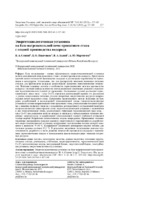| dc.contributor.author | Седнин, В. А. | |
| dc.contributor.author | Иванчиков, Е. О. | |
| dc.contributor.author | Калий, В. А. | |
| dc.contributor.author | Мартинчук, А. Ю. | |
| dc.coverage.spatial | Минск | ru |
| dc.date.accessioned | 2022-04-07T07:48:35Z | |
| dc.date.available | 2022-04-07T07:48:35Z | |
| dc.date.issued | 2022 | |
| dc.identifier.citation | Энерготехнологическая установка на базе нагревательной печи прокатного стана с опцией производства водорода = Energy-and-Technology Installation Based on a Rolling Mill Heating Furnace with the Option of Hydrogen Production / В. А. Седнин [и др.] // Известия высших учебных заведений и энергетических объединений СНГ. Энергетика. – 2022. – № 2. – С. 127-142. | ru |
| dc.identifier.uri | https://rep.bntu.by/handle/data/110971 | |
| dc.description.abstract | Цель исследования – оценка эффективности энерготехнологической установки на базе методической печи прокатного стана с опцией производства водорода. Представлен краткий анализ технологий производства водорода и рассмотрены перспективы их применения в металлургии. Установлено, что для предприятий, имеющих потенциал тепловых отходов, для производства водорода целесообразно применять термохимические технологии. Показаны основные аспекты и особенности термохимических методов производства водорода с позиций выбора количества этапов реализации химических реакций и определения термодинамических условий их проведения. Исследованы условия реализации термохимического цикла медь – хлор Cu–Cl, определен рациональный вариант его реализации с учетом использования тепловых отходов (вторичных энергетических ресурсов) нагревательных печей прокатного стана. Применение эволюционного метода позволило на базе ранее разработанной и исследованной технологической схемы (энерготехнологическая установка в составе нагревательной печи прокатного стана, утилизационной газовой турбины с внешним подводом теплоты с сохранением регенеративной составляющей подогрева воздуха-окислителя) синтезировать схему энерготехнологической установки с включением в нее технологического блока, реализующего гибридный термохимический цикл медь – хлор Cu–Cl для разделения воды на водород и кислород с использованием тепловых вторичных энергоресурсов и выработанной утилизационной газовой турбинной установкой электроэнергии. Разработана математическая модель макроуровня. Проведенные тестовые численные эксперименты показали высокую энергетическую перспективность разработанной энерготехнологической установки, коэффициент использования топлива которой находится в диапазоне 75–90 %. Коэффициент химической регенерации энергии топлива для тестового режима составил 11,3 %. В результате численного исследования доказана перспективность разработок в части развития технологий производства водорода с применением термохимических циклов и использования высокотемпературных тепловых вторичных ресурсов. | ru |
| dc.language.iso | ru | ru |
| dc.publisher | БНТУ | ru |
| dc.title | Энерготехнологическая установка на базе нагревательной печи прокатного стана с опцией производства водорода | ru |
| dc.title.alternative | Energy-and-Technology Installation Based on a Rolling Mill Heating Furnace with the Option of Hydrogen Production | ru |
| dc.type | Article | ru |
| dc.identifier.doi | 10.21122/1029-7448-2022-65-2-127-142 | |
| local.description.annotation | The aim of the study was to evaluate the efficiency of an energy-and-technology unit based on a continuous furnace of a rolling mill with an option for hydrogen production. A brief analysis of hydrogen production technologies and the prospects of their application in metallurgy are presented. It has been determined that as for enterprises with the potential of thermal waste, the use of thermochemical technologies is promising for the production of hydrogen. The main aspects and features of thermochemical methods of hydrogen production are shown from the standpoint of choosing the number of stages of chemical reactions implementation and determining the thermodynamic conditions for their conduct. The conditions for the implementation of the copper-chlorine Cu–Cl thermochemical cycle were investigated, and a rational variant of its implementation has been determined, taking into account the use of thermal waste (secondary energy resources) of the heating furnaces of the rolling mill. The application of the evolutionary method made it possible, on the basis of the technological scheme (which had been previously developed and investigated, and consisted of an energy-and-technological installation as a part of a rolling mill of a heating furnace and a utilization gas turbine with external heat supply that maintains the regenerative component of heating the air oxidizer), to synthesize a scheme of an energy-andtechnological installation with the inclusion of a technological unit implementing a hybrid thermochemical copper-chlorine Cu–Cl cycle for separating water into hydrogen and oxygen using thermal secondary energy resources and electricity generated by a utilization gas turbine installation. Mathematical model of the macro level has been developed. The conducted numerical test experiments have shown the high energy prospects of the developed energy-and-technology installation, the fuel utilization rate of which is in the range of 75–90 %. The coefficient of chemical regeneration of fuel energy for the test mode was 11.3 %. As a result of numerical research, the prospects of developments under consideration in terms of the development of hydrogen production technologies with the use of thermochemical cycles and the high-temperature thermal secondary resources have been proved. | ru |

